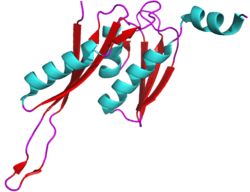Ribonucleoprotein particle

A ribonucleoprotein particle or RNP is a complex formed between RNA and RNA-binding proteins (RBPs).[1] The term 'RNP foci' is also used to denote an intracellular compartment involved in processing of RNA transcripts.
RNA/RBP complexes
RBPs interact with RNA through binding motifs. Aromatic amino acid residues in this RNA binding motif result in stacking interactions with RNA. Lysine residues in the helical portion of RNA binding proteins help to stabilize interactions with nucleic acids. This nucleic acid binding is a result of the force of attraction between the positive electrical charge of lysine side chains and the negative electrical charge of nucleic acid phosphate backbones. It is hypothesized that RNA sequences, called elements, in the 3'-untranslated region determine the binding of RBPs, and that these RBPs determine the post-transcriptional fate of mRNAs.
RNP granules
RNP granules are a highly diverse group of compartments. These include stress granules, processing bodies, and exosomes in somatic cells. Many RNP granules are cell type and/or species specific. For example, chromatoid bodies are found only in male germ cells, whereas transport granules have so far been found only in neurons and oocytes. RNP granules function mainly by physically separating or associating transcripts with proteins. They function in the storage, processing, degradation and transportation of their associated transcripts.
RNP granules have been shown to have particular importance in cells where post-transcriptional regulation is of vital importance. For example, in neurons where transcripts must be transported and stored in dendrites for the formation and strengthening of connections, in oocytes/embryos where mRNAs are stored for years before being translated, and in developing sperm cells where transcription is halted before development is complete.
See also
- Messenger RNP: complex between mRNA and protein(s) present in nucleus
- Heterogeneous ribonucleoprotein particle: complexes of RNA and protein present in the cell nucleus
References
- ↑ Stefl R, Skrisovska L, Allain FH (January 2005). "RNA sequence- and shape-dependent recognition by proteins in the ribonucleoprotein particle". EMBO Rep. 6 (1): 33–8. doi:10.1038/sj.embor.7400325. PMC 1299235
 . PMID 15643449.
. PMID 15643449.